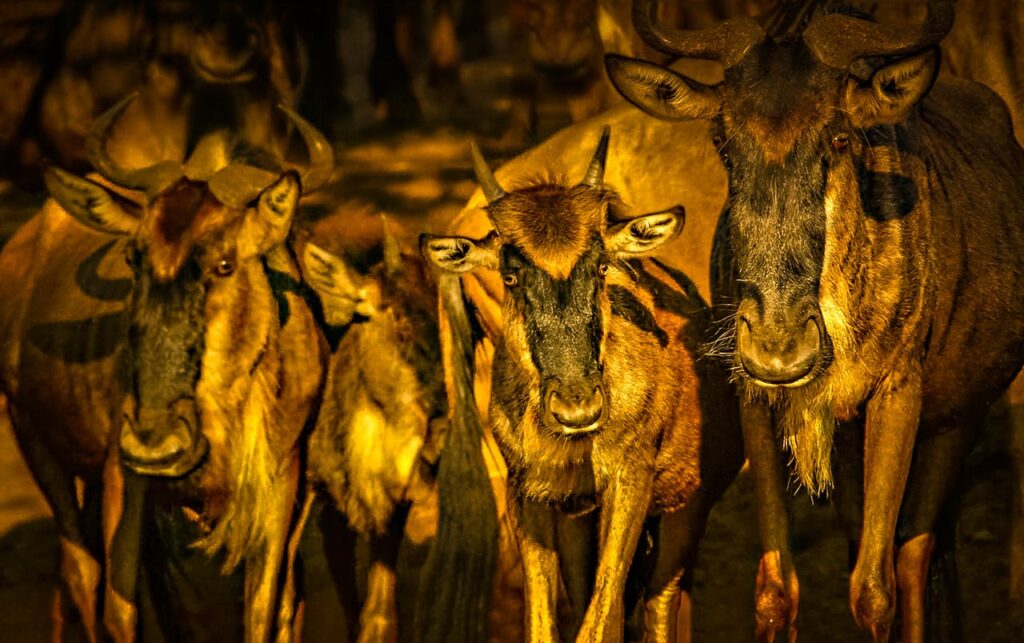The Masai Mara National Reserve, located in southwestern Kenya, is one of Africa’s most iconic wildlife conservation areas and a cornerstone of Kenya’s tourism and ecological heritage. This detailed factsheet outlines essential information and conservation statistics, referencing reliable academic and institutional sources.
1. Location & Size
- Coordinates: 1.4931° S, 35.1436° E
- Area: Approximately 1,510 km² (Narok County Government, 2022)
- Ecosystem: Part of the Greater Serengeti–Mara Ecosystem, which spans over 25,000 km² across Kenya and Tanzania (WWF, 2020)
- Altitude: Ranges from 1,500 to 2,170 meters above sea level
2. History & Management
- Established: Initially designated as a wildlife sanctuary in 1948; upgraded to a national reserve in 1961
- Management Authority: Managed by the Narok County Government, with additional governance in adjacent conservancies managed by local Maasai communities (Ogutu et al., 2011)
- Protected Status: Not a national park but a reserve, allowing seasonal grazing rights in some zones (Homewood et al., 2009)
3. Biodiversity Highlights
Mammals
- Home to over 95 species of mammals
- Big Five present: lion, leopard, elephant, buffalo, and black rhino
- Estimated population of lions: ~850 in the Greater Mara (Mara Predator Conservation Programme, 2022)
- Elephants: Over 2,400 individuals recorded in the Mara ecosystem (Mara Elephant Project, 2021)
Birds
- Over 470 species of birds documented (BirdLife International, 2020)
- Notable birds: Secretary bird, crowned crane, lilac-breasted roller (Kenya’s national bird)
4. The Great Migration
- One of the Seven Natural Wonders of Africa
- Involves the movement of ~1.5 million wildebeest, ~400,000 zebras, and ~200,000 Thomson’s gazelles from Tanzania’s Serengeti to Kenya’s Mara (Sinclair & Arcese, 1995)
- Crossings of the Mara River between July and October are the most dramatic events, drawing thousands of tourists
5. Land Use & Human-Wildlife Conflict
- The reserve is surrounded by over 15 community conservancies covering an additional 1,500 km² (Northern Rangelands Trust, 2021)
- Studies show that wildlife densities in some conservancies rival or exceed those inside the reserve (Western et al., 2009)
- Key threats: habitat fragmentation, overgrazing, fencing, and tourism congestion (Ogutu et al., 2011)
6. Economic Significance
- The Mara generates an estimated KES 2.5 billion ($20M) annually in tourism revenue (Narok County Economic Survey, 2020)
- Supports over 1,000 local jobs directly through tourism, and thousands more indirectly
- Entry fees range from $70–$80 per adult non-resident in peak season (Narok County Government, 2024)
7. Tourism & Visitor Stats
- Annual Visitors: Over 300,000 tourists per year (KWS, 2023)
- Peak visitation: July to October (Great Migration season)
- Main activities: game drives, balloon safaris, walking safaris (in conservancies), cultural visits
8. Accessibility
- By Road: ~270 km from Nairobi (6–7 hours by vehicle)
- By Air: Multiple daily flights from Nairobi’s Wilson Airport to several airstrips (e.g., Ol Kiombo, Musiara, Keekorok)
9. Conservation Programs
- Mara Elephant Project: anti-poaching, collaring, and data collection
- Mara Predator Conservation Programme: lion and cheetah tracking and mitigation of human-wildlife conflict
- Maasai Mara Wildlife Conservancies Association (MMWCA): umbrella body managing community-based conservancies
10. Challenges & Future Outlook
- Balancing tourism and conservation: Over-tourism at river crossings and limited enforcement of vehicle regulations
- Climate change: Shifts in rainfall affecting migration timing (Ogutu et al., 2014)
- Land fragmentation due to fencing and agriculture outside the reserve
🐾 Masai Mara’s Biodiversity: Why It’s Globally Significant
The Masai Mara National Reserve, along with its surrounding community conservancies, forms the northern tip of the Greater Serengeti-Mara Ecosystem, one of the most diverse and productive wildlife systems on Earth.
🌍 1. Species Richness
According to Sinclair & Arcese (1995) and updated data from Mara Predator Conservation Programme (2022):
| Taxonomic Group | Number of Species | Highlights |
|---|---|---|
| Mammals | 95+ species | Home to the Big Five and many migratory species |
| Birds | 470+ species | Includes 60+ raptors and 100+ waterbirds |
| Amphibians & Reptiles | ~100 species | Crocodiles, pythons, tree frogs, lizards |
| Insects (estimated) | 1,000+ species | Many yet undescribed; critical for pollination and food chains |
🧠 Fun Fact: The Masai Mara supports more large mammal biomass per hectare than almost any other ecosystem on Earth (Homewood et al., 2009).
🦁 2. Large Carnivore Populations
The Mara supports one of the highest densities of large predators in Africa.
Key predator stats:
- Lions: ~850 in the greater Mara area (MPCP, 2022)
- Cheetahs: ~50–70 individuals (with key coalition territories like the “Tano Bora”)
- Leopards: Widely distributed but elusive; densities of 6–10 individuals per 100 km² in some areas
- Spotted Hyenas: Densities of 40–60 individuals per clan in some zones (Sinclair et al.)
Why it matters: These apex predators regulate herbivore populations and maintain ecological balance—making the Mara a textbook model of predator-prey dynamics.
🐘 3. Herbivore Diversity and Migration Dynamics
The Great Migration is often the headline event, but the diversity of resident herbivores is just as remarkable.
Migratory Species:
- Wildebeest: ~1.5 million (Serengeti-Mara population)
- Zebras: ~400,000
- Thomson’s & Grant’s gazelles: ~300,000 combined
- Topi, eland, and hartebeest: Thousands migrate seasonally
Resident Species:
- Buffalo: ~15,000
- Elephants: ~2,400 in Mara-Serengeti transboundary range (Mara Elephant Project, 2021)
- Giraffes: Masai giraffe (endangered) common in conservancies
- Warthogs, impalas, bushbucks: Ubiquitous in wooded and riverine areas
🌿 4. Habitat Diversity Fuels Species Diversity
The Mara includes at least 7 distinct habitat types, each supporting different ecological communities:
| Habitat Type | Species Specialties |
|---|---|
| Riverine Forests | Leopards, Colobus monkeys, hornbills |
| Savannah Grasslands | Lions, wildebeest, cheetahs |
| Acacia Woodlands | Elephants, giraffes, bee-eaters |
| Swamps & Marshes | Hippos, shoebills (rare), amphibians |
| Hills & Escarpments | Hyraxes, raptors, orchids |
| Croton thickets | Nesting sites for birds, cover for ambush predators |
| Open Plains (short grass) | Migration herds, bustards, secretary birds |
🐦 5. Avifauna: A Birdwatcher’s Paradise
According to BirdLife International, the Masai Mara is an Important Bird Area (IBA).
- Raptors: Martial eagle, bateleur, augur buzzard
- Wetland Birds: African spoonbill, crowned crane, herons, ibis
- Endemics & Near-Endemics: Jackson’s widowbird, grey-crested helmetshrike
- Migratory Visitors: European rollers, barn swallows, Amur falcons (Sept–April)
🔎 Some birding hotspots include Musiara Marsh, Talek River, and Oloololo Escarpment.
🧬 6. Ecological Resilience & Keystone Species
- Elephants are ecological engineers—creating waterholes, dispersing seeds, and clearing thickets
- Termites and dung beetles enrich soils and facilitate nutrient cycling
- Maasai pastoralism, in zones with seasonal grazing, has been shown to support plant diversity when managed sustainably (Western et al., 2009)
🔬 7. Ongoing Research & Conservation
The Mara is a living laboratory. Ongoing projects include:
- Long-term carnivore studies (since 1980s)
- Wildlife tracking with GPS collars
- Camera trap surveys to monitor elusive species
- Biodiversity monitoring in community conservancies
Masai Mara National Reserve: Key Facts, Landmarks & Wildlife Wonders
The Masai Mara, located in southwestern Kenya, is one of Africa’s most biologically rich and scenic ecosystems. Covering just 1,510 km², it punches far above its size in terms of wildlife density, ecological importance, and global recognition. It forms the northern section of the vast Serengeti-Mara Ecosystem, which spans over 25,000 km² into Tanzania’s Serengeti National Park.
📍 1. Landmark Regions & Wildlife Hotspots
🐾 Musiara Marsh
- One of the most iconic lion habitats in Africa.
- Home to the famous Marsh Pride featured in BBC’s Big Cat Diary.
- Dense reeds, acacia fringes, and year-round water attract elephants, buffalo, and big cats.
- Excellent for sightings of leopards, hippos, and a diversity of birdlife.
Fun Fact: The area supports some of the highest lion densities in East Africa—up to 25 lions per 100 km² (MPCP, 2022).
🌿 Paradise Plains
- Wide open grasslands along the Mara River—prime hunting ground for cheetahs and hyenas.
- Known for dramatic scenes during the Great Migration as wildebeest herds flood in.
- Ideal for photography with golden light, low vegetation, and clear views.
Tip: This is one of the best places in the Mara for seeing cheetahs on the hunt in daylight hours.
🐆 Talek Area
- Located near Talek Gate, this is a mosaic of riverine forest, grasslands, and dense thickets.
- High density of leopards along the Talek River.
- Close to several major camps, making it popular for early morning drives.
Ecological Importance: Talek River acts as a lifeline during dry seasons, drawing in elephants, impalas, giraffes, and elusive predators.
🦓 Mara Triangle
- The western wedge of the reserve, managed separately by the Mara Conservancy.
- Borders the Mara River and the Oloololo Escarpment (also known as the Siria Escarpment).
- Known for better road infrastructure, strict rules, and low vehicle congestion.
- Great for migration river crossings between July–October.
Best Time to Visit: July to September for migration drama, but also exceptional in January–February with fewer crowds and resident predators.
⛰️ Oloololo Escarpment
- A dramatic ridge forming the western wall of the Rift Valley.
- Offers panoramic views over the Mara plains and into the Serengeti.
- Supports unique flora and nesting raptors like martial eagles.
Photographer’s Dream: Best place to watch golden-hour light roll across the Mara plains.
🦒 Ngama Hills (East Mara)
- Rolling hills and woodlands in the eastern section of the park.
- Less crowded, with large elephant herds, giraffes, and plains game.
- Leopards are known to hunt in the thickets here.
🦁 2. Wildlife Concentration & Species Stats
| Species | Estimated Population in Mara Ecosystem | Key Notes |
|---|---|---|
| Lions | ~850 | Highest density in Kenya (MPCP, 2022) |
| Cheetahs | ~50–70 | Most active in Paradise Plains & Olare Motorogi |
| Leopards | Widespread, elusive | Common along Talek and Mara Rivers |
| Elephants | ~2,400 | Roam freely across Mara and Serengeti |
| Hippos | 4,000+ | Concentrated in Mara River bends and pools |
| Wildebeest (Migratory) | ~1.5 million | Serengeti-Mara cross-border population |
| Birds | 470+ species | 60+ raptors, 100+ waterbirds, endemics too |
Key Point: The Masai Mara supports one of the highest densities of large predators per square kilometer in the world.
🌱 3. Size Comparison with Serengeti
| Park | Size (km²) | Country |
|---|---|---|
| Masai Mara NR | 1,510 | Kenya |
| Serengeti NP | 14,763 | Tanzania |
Though the Serengeti is nearly 10 times larger, the Mara’s dense predator population, permanent water sources, and rich grasslands make it one of the most productive 1,500 km² anywhere in Africa.
🛡️ 4. Conservation & Community Role
- Managed By: Narok County Government (Mara Triangle managed separately by the Mara Conservancy)
- Buffer Zone: Surrounded by 15+ conservancies, covering ~1,500 km²
- Key Community Conservancies:
- Olare Motorogi – elite big cat territory
- Naboisho Conservancy – high elephant and lion density
- Mara North – mixed-use with tourism and pastoralism
- MMWCA (Maasai Mara Wildlife Conservancies Association) leads collaborative conservation
- Community Impact: Conservancies employ 1,000+ Maasai, fund schools and health projects
🧠 Quote: “Conservancies have allowed wildlife populations to stabilize or grow outside the reserve.” — Western et al., Biological Conservation (2009)
🧳 5. What Makes Masai Mara Unique?
- The only place in the world where you can witness the Great Migration river crossings with a backdrop of the Big Five, in open vehicle safaris, surrounded by Maasai-led conservancies.
- Dual governance model: public reserve + private conservancies makes for varied safari styles.
- Night drives, walking safaris, and low-density tourism allowed in conservancies but not in the core reserve.
🎯 Summary
| Feature | Masai Mara’s Distinction |
|---|---|
| Predator Density | Highest per km² in Kenya |
| Scenic Diversity | Escarpments, plains, rivers, marshes |
| Community Conservation Model | Globally praised – over 40% of wildlife now outside reserve |
| Migration Viewing | Best river crossing views (July–October) |
| Accessibility | Multiple airstrips and good road links from Nairobi |

